warning lights FORD E-350 2002 Owners Manual
[x] Cancel search | Manufacturer: FORD, Model Year: 2002, Model line: E-350, Model: FORD E-350 2002Pages: 256, PDF Size: 3.52 MB
Page 1 of 256
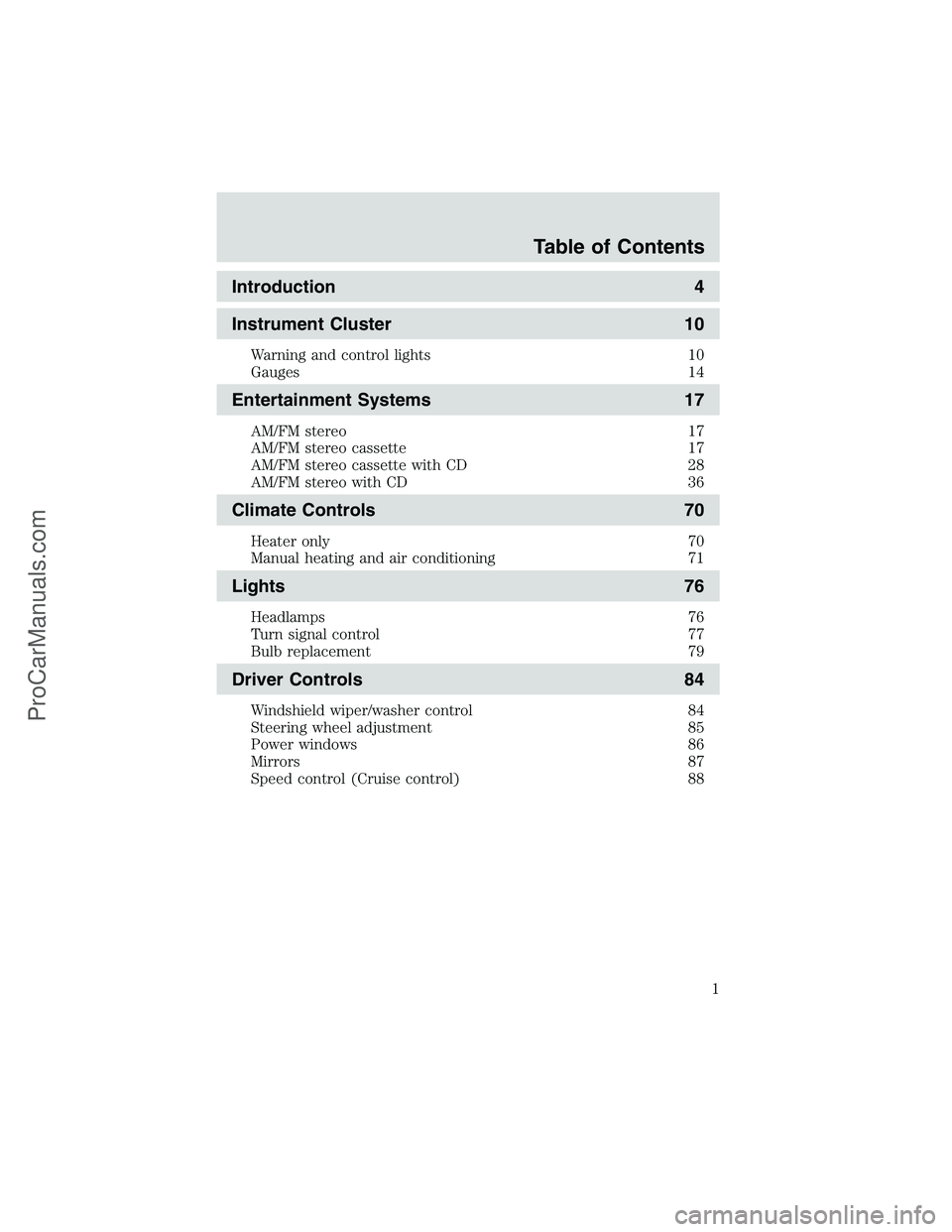
Introduction 4
Instrument Cluster 10
Warning and control lights 10
Gauges 14
Entertainment Systems 17
AM/FM stereo 17
AM/FM stereo cassette 17
AM/FM stereo cassette with CD 28
AM/FM stereo with CD 36
Climate Controls 70
Heater only 70
Manual heating and air conditioning 71
Lights 76
Headlamps 76
Turn signal control 77
Bulb replacement 79
Driver Controls 84
Windshield wiper/washer control 84
Steering wheel adjustment 85
Power windows 86
Mirrors 87
Speed control (Cruise control) 88
Table of Contents
1
ProCarManuals.com
Page 10 of 256
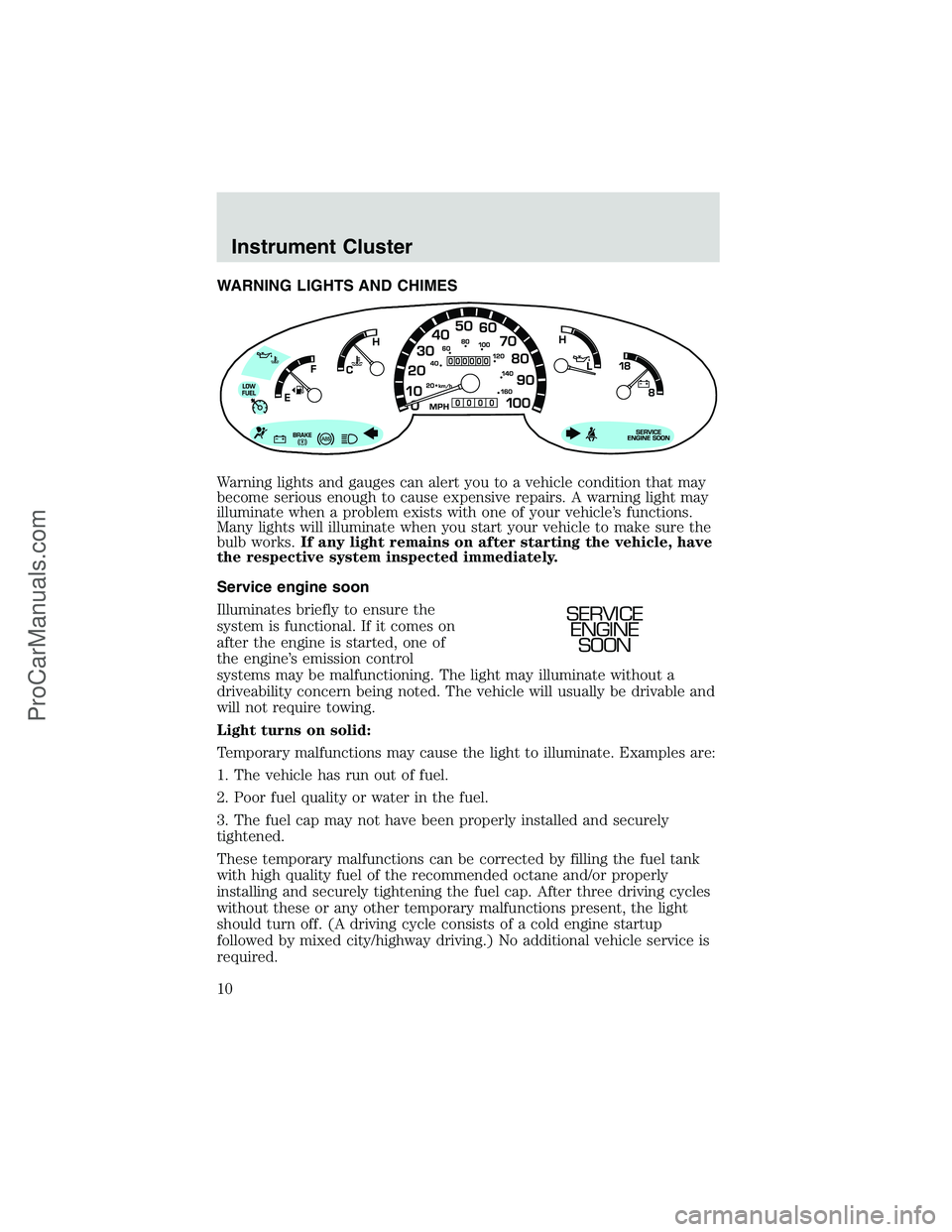
WARNING LIGHTS AND CHIMES
Warning lights and gauges can alert you to a vehicle condition that may
become serious enough to cause expensive repairs. A warning light may
illuminate when a problem exists with one of your vehicle’s functions.
Many lights will illuminate when you start your vehicle to make sure the
bulb works.If any light remains on after starting the vehicle, have
the respective system inspected immediately.
Service engine soon
Illuminates briefly to ensure the
system is functional. If it comes on
after the engine is started, one of
the engine’s emission control
systems may be malfunctioning. The light may illuminate without a
driveability concern being noted. The vehicle will usually be drivable and
will not require towing.
Light turns on solid:
Temporary malfunctions may cause the light to illuminate. Examples are:
1. The vehicle has run out of fuel.
2. Poor fuel quality or water in the fuel.
3. The fuel cap may not have been properly installed and securely
tightened.
These temporary malfunctions can be corrected by filling the fuel tank
with high quality fuel of the recommended octane and/or properly
installing and securely tightening the fuel cap. After three driving cycles
without these or any other temporary malfunctions present, the light
should turn off. (A driving cycle consists of a cold engine startup
followed by mixed city/highway driving.) No additional vehicle service is
required.
SERVICE
ENGINE
SOON
Instrument Cluster
10
ProCarManuals.com
Page 13 of 256
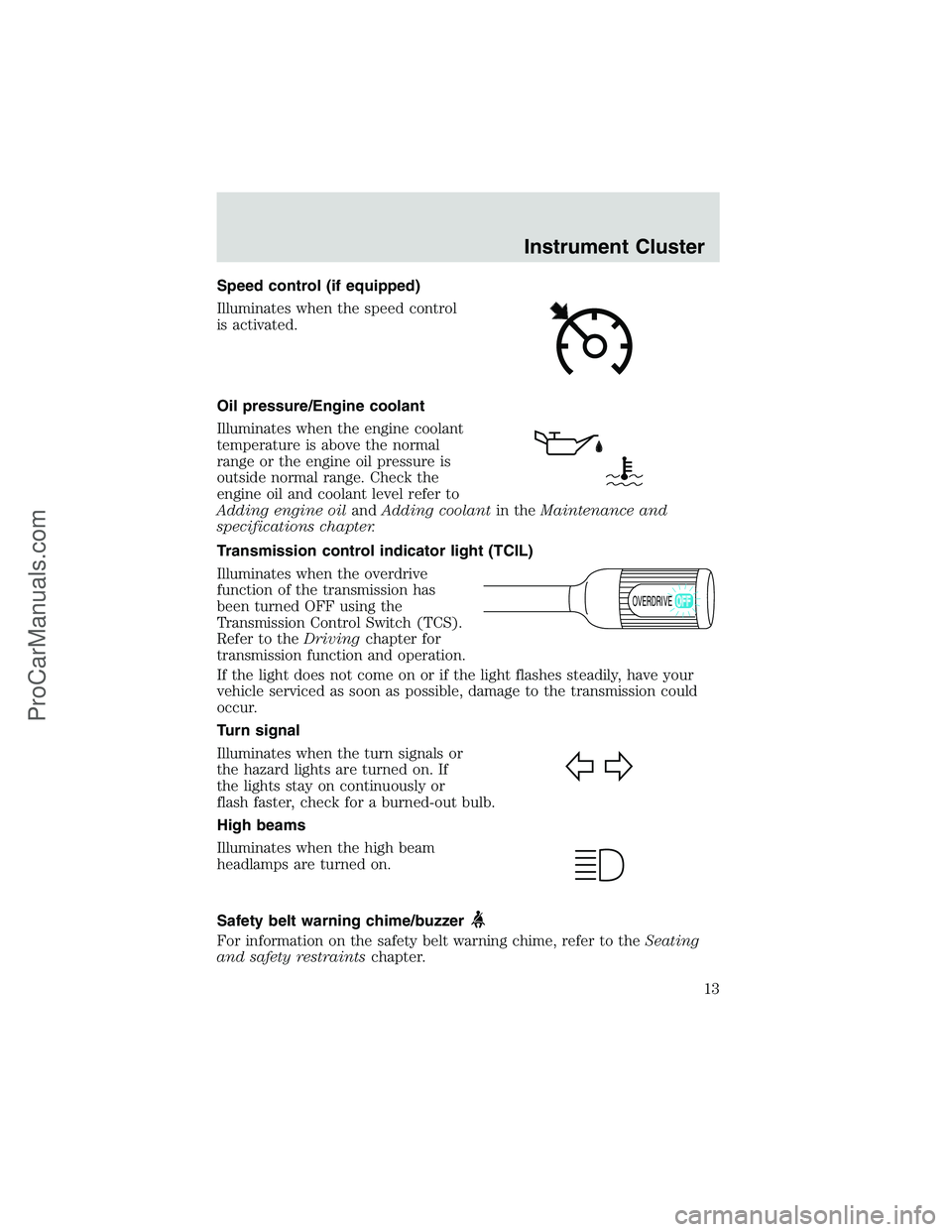
Speed control (if equipped)
Illuminates when the speed control
is activated.
Oil pressure/Engine coolant
Illuminates when the engine coolant
temperature is above the normal
range or the engine oil pressure is
outside normal range. Check the
engine oil and coolant level refer to
Adding engine oilandAdding coolantin theMaintenance and
specifications chapter.
Transmission control indicator light (TCIL)
Illuminates when the overdrive
function of the transmission has
been turned OFF using the
Transmission Control Switch (TCS).
Refer to theDrivingchapter for
transmission function and operation.
If the light does not come on or if the light flashes steadily, have your
vehicle serviced as soon as possible, damage to the transmission could
occur.
Turn signal
Illuminates when the turn signals or
the hazard lights are turned on. If
the lights stay on continuously or
flash faster, check for a burned-out bulb.
High beams
Illuminates when the high beam
headlamps are turned on.
Safety belt warning chime/buzzer
For information on the safety belt warning chime, refer to theSeating
and safety restraintschapter.
OVERDRIVE
Instrument Cluster
13
ProCarManuals.com
Page 136 of 256
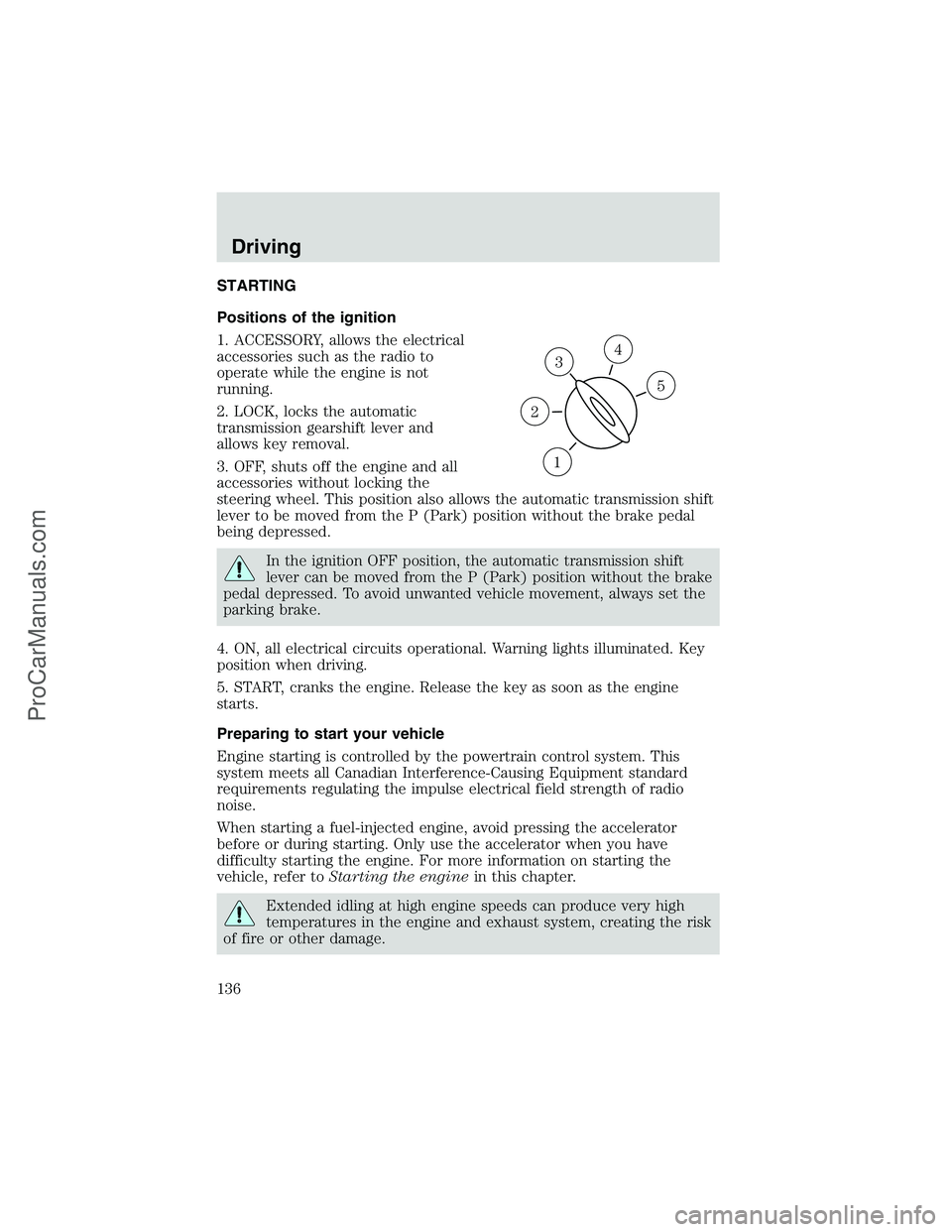
STARTING
Positions of the ignition
1. ACCESSORY, allows the electrical
accessories such as the radio to
operate while the engine is not
running.
2. LOCK, locks the automatic
transmission gearshift lever and
allows key removal.
3. OFF, shuts off the engine and all
accessories without locking the
steering wheel. This position also allows the automatic transmission shift
lever to be moved from the P (Park) position without the brake pedal
being depressed.
In the ignition OFF position, the automatic transmission shift
lever can be moved from the P (Park) position without the brake
pedal depressed. To avoid unwanted vehicle movement, always set the
parking brake.
4. ON, all electrical circuits operational. Warning lights illuminated. Key
position when driving.
5. START, cranks the engine. Release the key as soon as the engine
starts.
Preparing to start your vehicle
Engine starting is controlled by the powertrain control system. This
system meets all Canadian Interference-Causing Equipment standard
requirements regulating the impulse electrical field strength of radio
noise.
When starting a fuel-injected engine, avoid pressing the accelerator
before or during starting. Only use the accelerator when you have
difficulty starting the engine. For more information on starting the
vehicle, refer toStarting the enginein this chapter.
Extended idling at high engine speeds can produce very high
temperatures in the engine and exhaust system, creating the risk
of fire or other damage.
3
1
2
5
4
Driving
136
ProCarManuals.com
Page 224 of 256
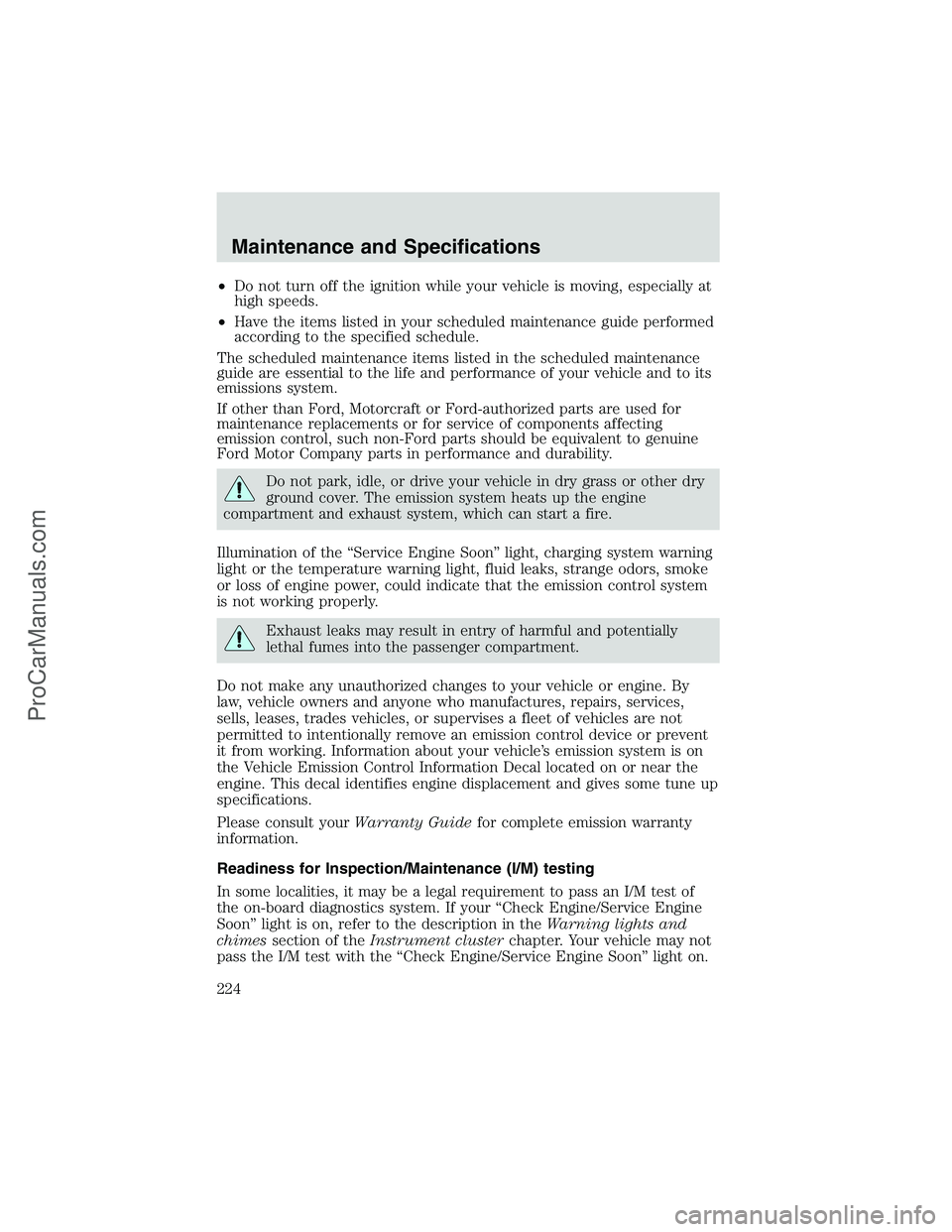
•Do not turn off the ignition while your vehicle is moving, especially at
high speeds.
•Have the items listed in your scheduled maintenance guide performed
according to the specified schedule.
The scheduled maintenance items listed in the scheduled maintenance
guide are essential to the life and performance of your vehicle and to its
emissions system.
If other than Ford, Motorcraft or Ford-authorized parts are used for
maintenance replacements or for service of components affecting
emission control, such non-Ford parts should be equivalent to genuine
Ford Motor Company parts in performance and durability.
Do not park, idle, or drive your vehicle in dry grass or other dry
ground cover. The emission system heats up the engine
compartment and exhaust system, which can start a fire.
Illumination of the“Service Engine Soon”light, charging system warning
light or the temperature warning light, fluid leaks, strange odors, smoke
or loss of engine power, could indicate that the emission control system
is not working properly.
Exhaust leaks may result in entry of harmful and potentially
lethal fumes into the passenger compartment.
Do not make any unauthorized changes to your vehicle or engine. By
law, vehicle owners and anyone who manufactures, repairs, services,
sells, leases, trades vehicles, or supervises a fleet of vehicles are not
permitted to intentionally remove an emission control device or prevent
it from working. Information about your vehicle’s emission system is on
the Vehicle Emission Control Information Decal located on or near the
engine. This decal identifies engine displacement and gives some tune up
specifications.
Please consult yourWarranty Guidefor complete emission warranty
information.
Readiness for Inspection/Maintenance (I/M) testing
In some localities, it may be a legal requirement to pass an I/M test of
the on-board diagnostics system. If your“Check Engine/Service Engine
Soon”light is on, refer to the description in theWarning lights and
chimessection of theInstrument clusterchapter. Your vehicle may not
pass the I/M test with the“Check Engine/Service Engine Soon”light on.
Maintenance and Specifications
224
ProCarManuals.com
Page 253 of 256
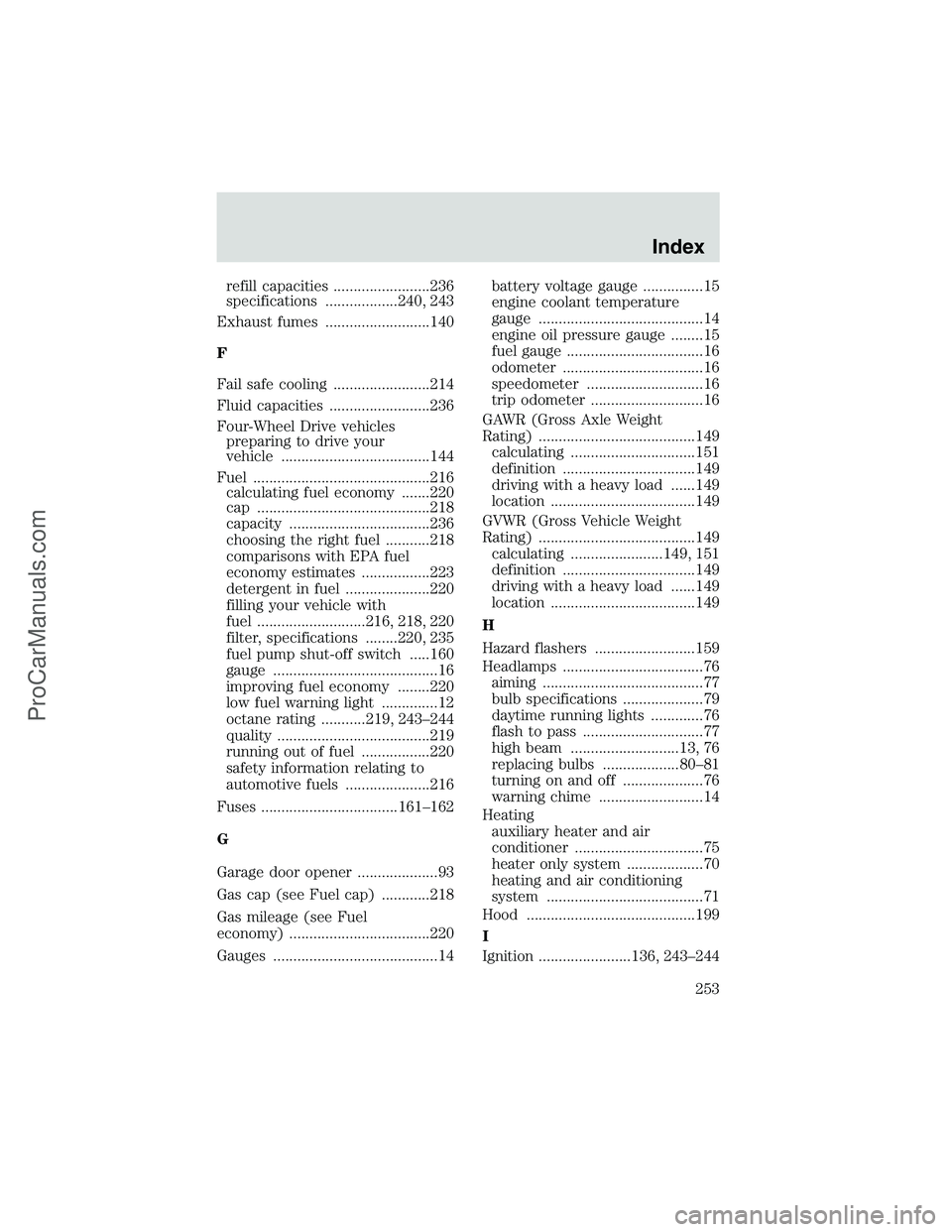
refill capacities ........................236
specifications ..................240, 243
Exhaust fumes ..........................140
F
Fail safe cooling ........................214
Fluid capacities .........................236
Four-Wheel Drive vehicles
preparing to drive your
vehicle .....................................144
Fuel ............................................216
calculating fuel economy .......220
cap ...........................................218
capacity ...................................236
choosing the right fuel ...........218
comparisons with EPA fuel
economy estimates .................223
detergent in fuel .....................220
filling your vehicle with
fuel ...........................216, 218, 220
filter, specifications ........220, 235
fuel pump shut-off switch .....160
gauge .........................................16
improving fuel economy ........220
low fuel warning light ..............12
octane rating ...........219, 243–244
quality ......................................219
running out of fuel .................220
safety information relating to
automotive fuels .....................216
Fuses ..................................161–162
G
Garage door opener ....................93
Gas cap (see Fuel cap) ............218
Gas mileage (see Fuel
economy) ...................................220
Gauges .........................................14battery voltage gauge ...............15
engine coolant temperature
gauge .........................................14
engine oil pressure gauge ........15
fuel gauge ..................................16
odometer ...................................16
speedometer .............................16
trip odometer ............................16
GAWR (Gross Axle Weight
Rating) .......................................149
calculating ...............................151
definition .................................149
driving with a heavy load ......149
location ....................................149
GVWR (Gross Vehicle Weight
Rating) .......................................149
calculating .......................149, 151
definition .................................149
driving with a heavy load ......149
location ....................................149
H
Hazard flashers .........................159
Headlamps ...................................76
aiming ........................................77
bulb specifications ....................79
daytime running lights .............76
flash to pass ..............................77
high beam ...........................13, 76
replacing bulbs ...................80–81
turning on and off ....................76
warning chime ..........................14
Heating
auxiliary heater and air
conditioner ................................75
heater only system ...................70
heating and air conditioning
system .......................................71
Hood ..........................................199
I
Ignition .......................136, 243–244
Index
253
ProCarManuals.com
Page 254 of 256
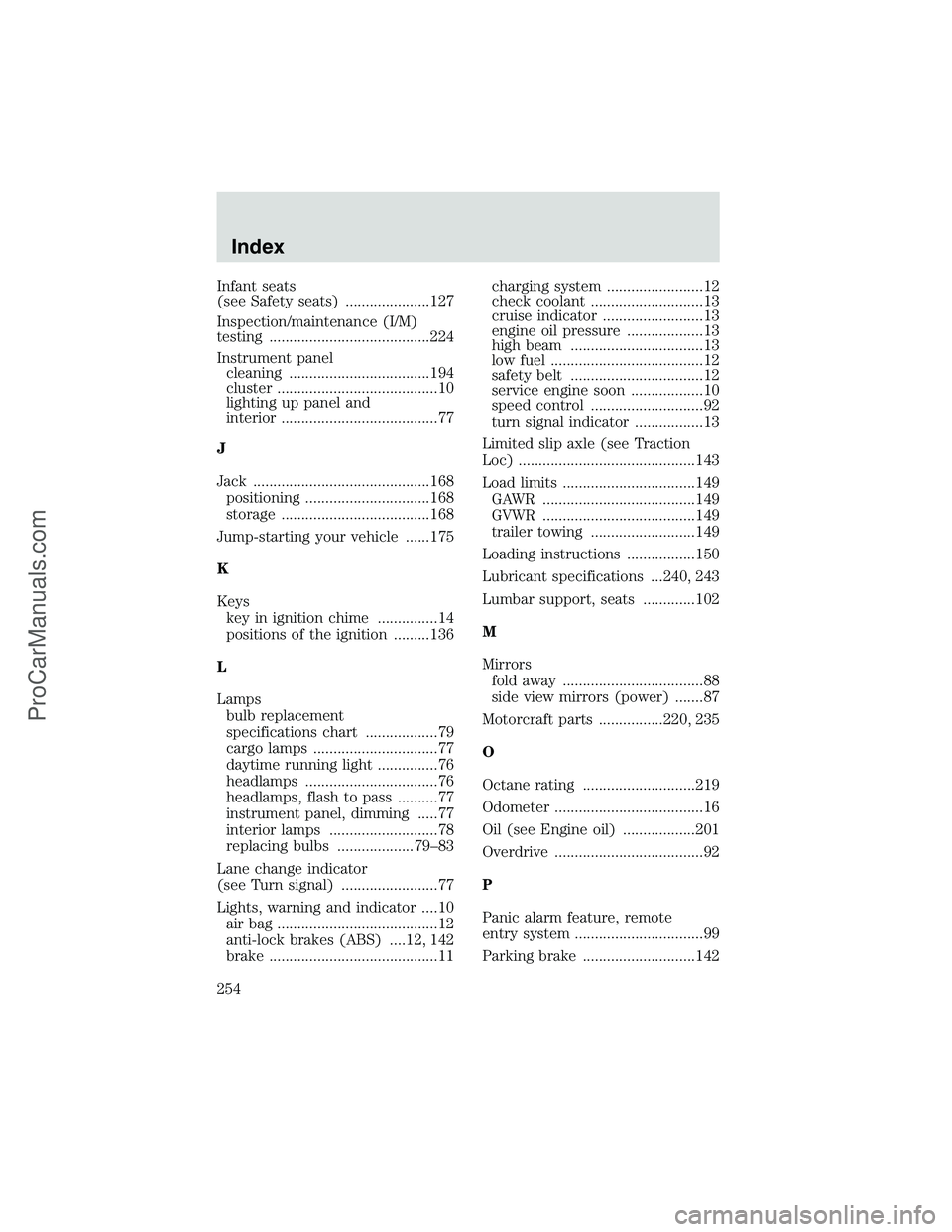
Infant seats
(see Safety seats) .....................127
Inspection/maintenance (I/M)
testing ........................................224
Instrument panel
cleaning ...................................194
cluster ........................................10
lighting up panel and
interior .......................................77
J
Jack ............................................168
positioning ...............................168
storage .....................................168
Jump-starting your vehicle ......175
K
Keys
key in ignition chime ...............14
positions of the ignition .........136
L
Lamps
bulb replacement
specifications chart ..................79
cargo lamps ...............................77
daytime running light ...............76
headlamps .................................76
headlamps, flash to pass ..........77
instrument panel, dimming .....77
interior lamps ...........................78
replacing bulbs ...................79–83
Lane change indicator
(see Turn signal) ........................77
Lights, warning and indicator ....10
air bag ........................................12
anti-lock brakes (ABS) ....12, 142
brake ..........................................11charging system ........................12
check coolant ............................13
cruise indicator .........................13
engine oil pressure ...................13
high beam .................................13
low fuel ......................................12
safety belt .................................12
service engine soon ..................10
speed control ............................92
turn signal indicator .................13
Limited slip axle (see Traction
Loc) ............................................143
Load limits .................................149
GAWR ......................................149
GVWR ......................................149
trailer towing ..........................149
Loading instructions .................150
Lubricant specifications ...240, 243
Lumbar support, seats .............102
M
Mirrors
fold away ...................................88
side view mirrors (power) .......87
Motorcraft parts ................220, 235
O
Octane rating ............................219
Odometer .....................................16
Oil (see Engine oil) ..................201
Overdrive .....................................92
P
Panic alarm feature, remote
entry system ................................99
Parking brake ............................142
Index
254
ProCarManuals.com
Page 256 of 256
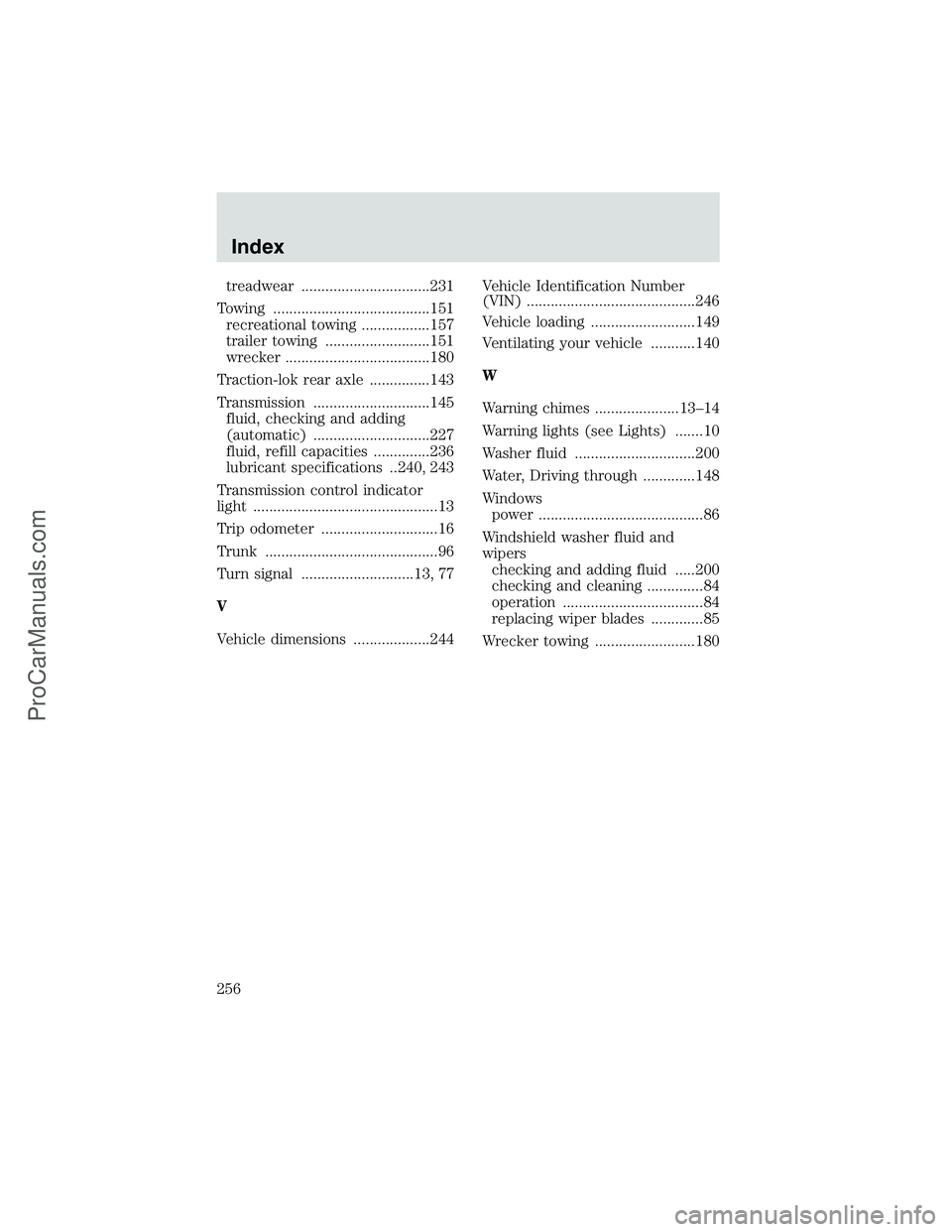
treadwear ................................231
Towing .......................................151
recreational towing .................157
trailer towing ..........................151
wrecker ....................................180
Traction-lok rear axle ...............143
Transmission .............................145
fluid, checking and adding
(automatic) .............................227
fluid, refill capacities ..............236
lubricant specifications ..240, 243
Transmission control indicator
light ..............................................13
Trip odometer .............................16
Trunk ...........................................96
Turn signal ............................13, 77
V
Vehicle dimensions ...................244Vehicle Identification Number
(VIN) ..........................................246
Vehicle loading ..........................149
Ventilating your vehicle ...........140
W
Warning chimes .....................13–14
Warning lights (see Lights) .......10
Washer fluid ..............................200
Water, Driving through .............148
Windows
power .........................................86
Windshield washer fluid and
wipers
checking and adding fluid .....200
checking and cleaning ..............84
operation ...................................84
replacing wiper blades .............85
Wrecker towing .........................180
Index
256
ProCarManuals.com